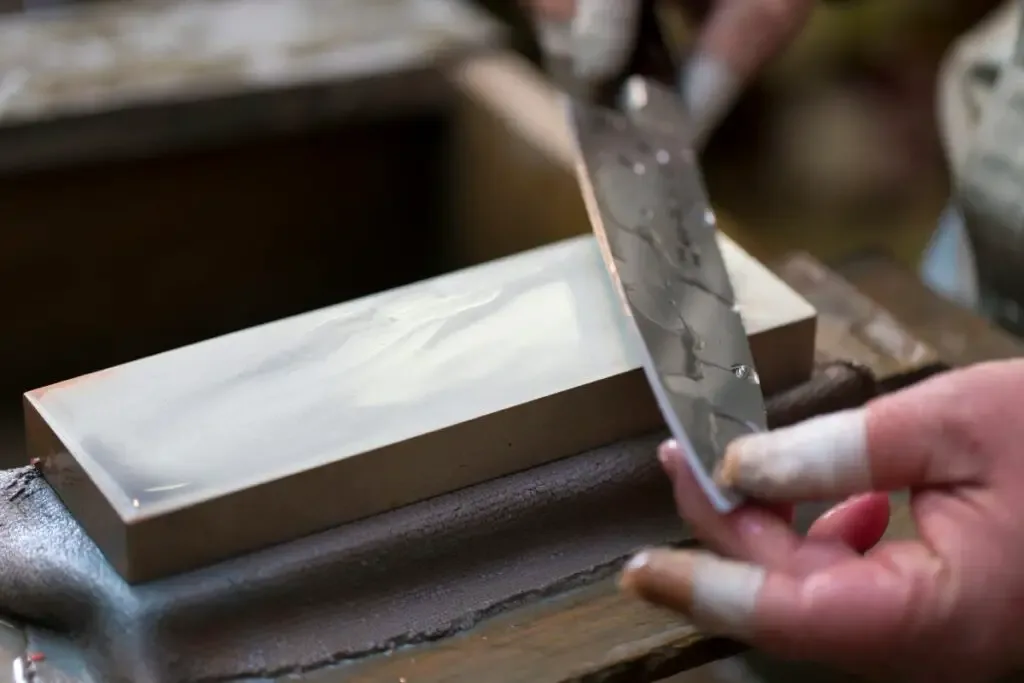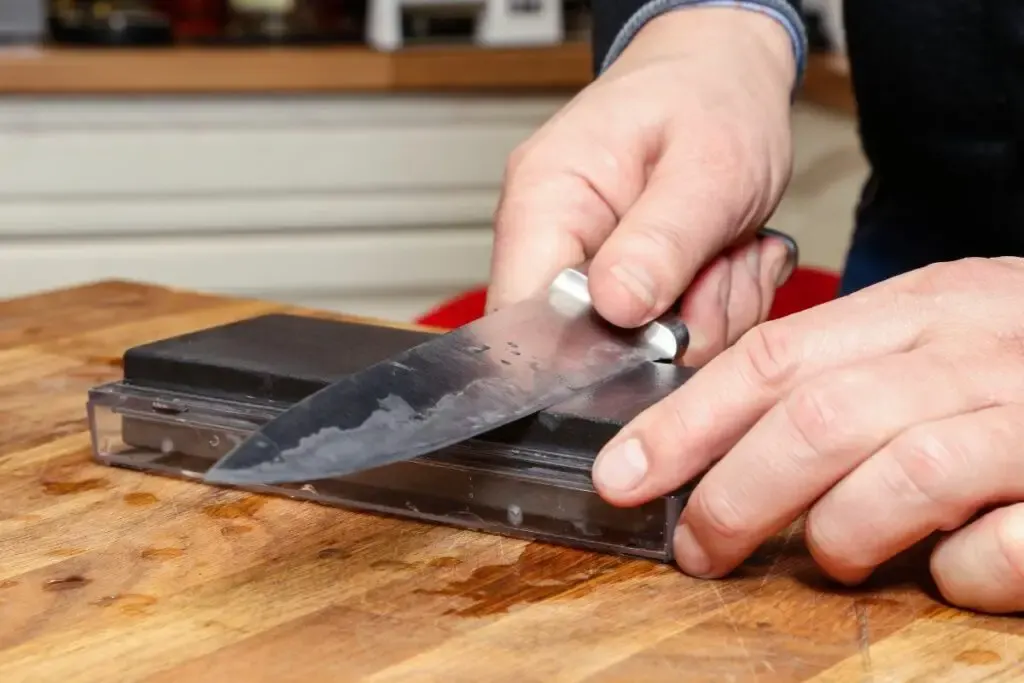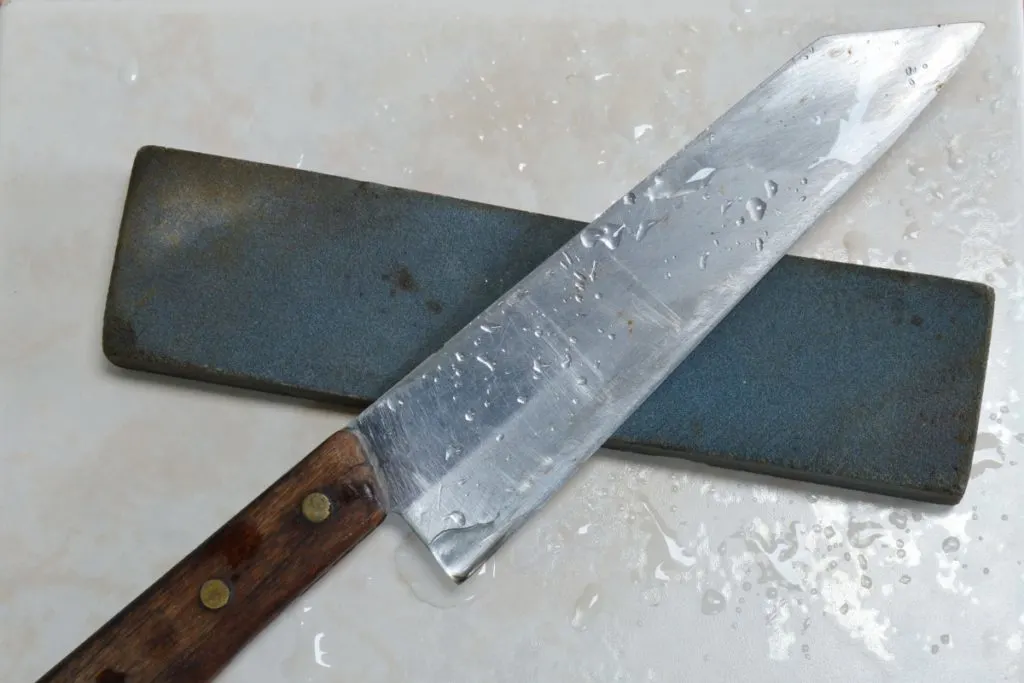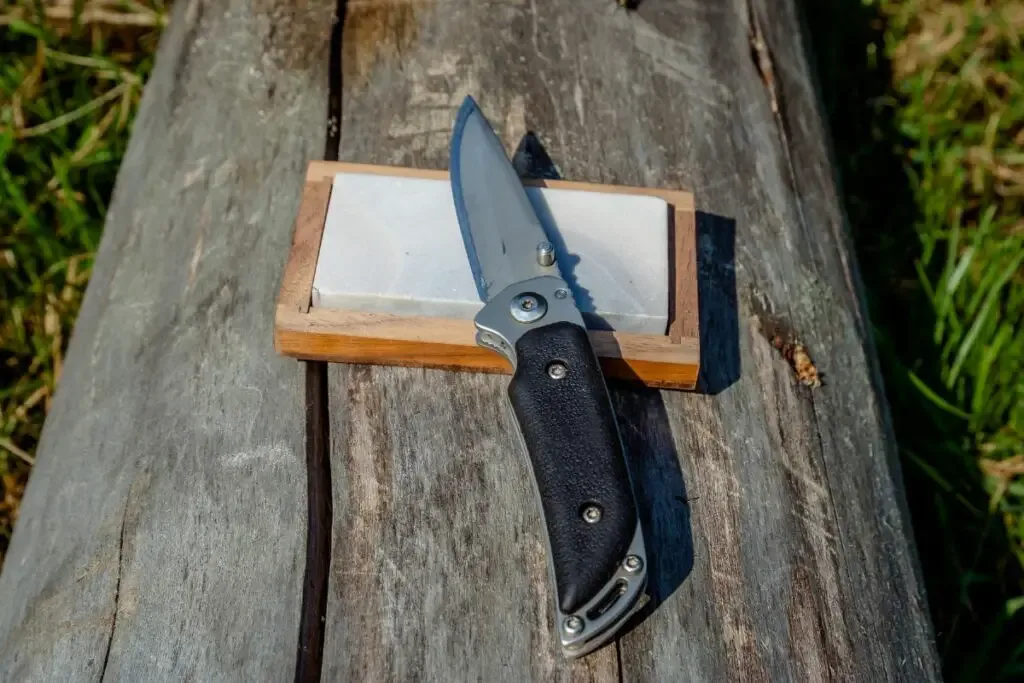As an Amazon Associate, we earn from qualifying purchases with no additional costs for you.
Whetstones can be an expensive investment for people starting out learning this sharpening technique, which tempts them to buy cheap whetstones. After all, they are just abrasives that remove steel from the knife’s edge! This approach does not work with whetstones, as there is a significant difference between cheap and expensive whetstones, and you will notice this when you start to use the stones.
Expensive whetstones are better quality than cheap ones for the following reasons.
- The quality of the abrasive used in the stone.
- The time it takes to sharpen a knife
- The effectiveness of sharpening a knife.
- How the stone wears.
- The user experience on a cheap stone vs. an expensive stone.
When purchasing whetstones, cheap whetstones usually reflect the quality of the stone, which means you can get cheap stones, medium-quality stones, and high-quality whetstones.
The price you pay for the stone will generally affect the quality of the stone and the quality of the sharpening job on your knife. But are these differences significant enough to warrant the cost of expensive whetstones?
If you are interested in checking out the best whetstones for your knives, we recommend and use you can find them by clicking here (Amazon link).

Are Expensive Whetstones Worth It?
Expensive whetstones are not just expensive; they are very expensive. This cost aspect of these quality whetstones is a deterring factor for many people, especially beginners to the craft.
Expensive whetstones are definitely worth the cost but are not recommended for beginners who could ruin the expensive whetstones with poor technique. Beginners to whetstone sharpening would do better with medium-priced stones to learn the skill.
Cheap stones are not recommended for beginners as they will provide an inaccurate sharpening experience, which will develop bad habits and an incorrect perspective of sharpening knives with this method.
Are More Expensive Whetstones Better?

In some products, a higher price does not equate to significantly higher standard differences in the product. Whetstones do not fall into this category, and the differences between cheap, medium, and expensive whetstones are marked.
More expensive whetstones are at the top of the range of products in the whetstone category, making them a superior product. The materials used as the abrasive are better quality, more durable, and the care taken in the manufacture is higher. This results in an all-around better product.
Cheap whetstones are simply not worth buying because you will be frustrated with the experience of trying to learn on these stones, the result will not be what you expect, and you will need to replace the stones much sooner than you would a more expensive stone.
TIP: Are you looking to buy a new whetstone? Check out our recommendations of whetstones we personally use (Amazon links):
Fixing stone: Whetstone SHAPTON Ceramic KUROMAKU #320
Sharpening stone: Suehiro CERAX soaking whetstone: Medium #1000
Finishing stone: Whetstone SHAPTON Ceramic KUROMAKU #5000
Why Are Whetstones So Expensive?

Some whetstones are expensive enough to make any prospective buyer swallow hard when they see the price of these stones.
Whetstones can be expensive because of the quality of the material that goes into the product’s construction. The processes used to make a higher quality, durable, flat, and level whetstone also contribute to the final price of the stone.
Cheaper whetstones can be sourced and will do a good job of sharpening, but there is a limit to how low you can go in price and still get a whetstone that will perform well.
We have an extensive article on How To Choose And Buy A Whetstone: The Ultimate Buyer’s Guide that will help you select a good stone for your budget.
TIP: The last step of the proper sharpening process should be stropping. Do you know what stropping a knife exactly does? Find out the answer in the article below:
Simple Explanation: What Does Stropping A Knife Do Exactly?
Are Cheap Whetstones Any Good?

Of course, you will always get the exception to the rule where you will find a cheap whetstone that will perform at a higher level than other cheap whetstones, but this is not a common occurrence.
Some cheap whetstones can do a halfway decent job of sharpening a knife. It is always a roll of the dice buying a cheap stone, whether you will get a good cheap whetstone or waste your money on a poor quality stone. It is preferable to pay a little more and be sure of the quality you are buying.
Generally speaking, the price of a whetstone will be a fair indicator of the stone’s quality. Cheaper stones in the upper price category of the cheap range will outperform cheaper stones in the same category.
They may even perform closer to a medium-quality stone, but the same cannot be said of cheaper stones lower down in the pecking order.
Our budget choice: Sharp Pebble Extra Large Sharpening Stone Set (Amazon Link)
This set from Sharp Pebble will give you great value for money and the ability to take any knife from dull to razor-sharp with the combination of stones that are included in the package.
Difference Between Cheap And Expensive Whetstone

There are many differences between cheap whetstones and expensive whetstones. The differences will be noticed in the wear of the stone and the result on the knife.
1. The Quality Of The Abrasive Used In The Whetstone
When you break it down, the basic function of a whetstone is to remove metal from the knife’s edge.
The ability of the whetstone to perform well in this basic function will be determined by the quality of the abrasive used in the manufacture of the stone.
Essentially, expensive whetstones use quality abrasives. Cheap whetstones use cheap abrasives. The quality of the abrasive will affect how efficient the whetstone is and the quality of the edge that it will put on a knife. Cheaper abrasives simply do not work as well as higher-quality abrasives.
Whether the abrasive is silicon carbide or aluminum oxide, you will get different grades of these materials, which affect the cost of the whetstone. An important aspect of the abrasive is its uniformity throughout the stone.
High-quality abrasives will be of a consistent coarseness throughout the composition of the stone. Cheap abrasives do not have this consistency, which affects the wear on the stone and the quality of the edge put on the knife.
TIP: Many people are not sure if whetstones need to be wet. But this knowledge is crucial when sharpening knives on a whetstone. Finy out the correct answer in the article below:
Do Sharpening Stones Need To Be Wet? Complete Breakdown
2. The Time It Takes To Sharpen A Knife
Time is an important factor when sharpening a knife, particularly if you have several knives to sharpen. The cutting ability of the abrasive will affect how long it takes to get an edge on the knife.
More expensive whetstones will have a higher quality abrasive which will cut through the steel at a higher and more consistent rate than a cheap whetstone. This makes the sharpening process on an expensive whetstone much quicker than on a cheap whetstone.
The abrasives in cheap whetstones are not as effective at removing steel, resulting in the sharpening process taking significantly longer on a cheap stone. The time taken to sharpen a knife on a cheap stone could easily be double that of an expensive, higher-quality stone.
3. The Effectiveness Of Sharpening A Knife
The quality of the whetstone, which translates to a higher purchase price, will affect the effectiveness of the stone on the knife.
The higher quality of the abrasives on an expensive whetstone will cut the knife’s steel faster, more evenly and give the knife a sharper edge. Cheap whetstones will take longer to do the same job, and the finish on the edge of the knife will not be as smooth and uniform as with a better whetstone.
High-quality whetstones will make the cutting edge of the knife smooth, even, and straight. This will enable the person doing the sharpening to bring the knife’s edge to a much higher sharpness level and with less effort.
TIP: Do cheap whetstones wear out faster than expensive whetstones? This is one the most important features of good whetstone. Find out the exact values for various sharpeners in the article below:
Do Knife Sharpeners Wear Out? Answer for Various Sharpeners
4. How The Whetstone Wears
The wear that whetstones experience during use will affect the lifespan of the stone and the effectiveness of the stone for sharpening.
The poorer quality of cheap whetstones will cause them to wear faster and unevenly, further complicating the process of trying to sharpen a knife on the stone. The cheap stone will wear out faster than a more expensive stone and must be replaced much more frequently.
Expensive stones will wear at a more constant rate due to the consistency of the higher-quality abrasive throughout the stone.
The rate that an expensive stone wears will also be slower because the abrasive is more effective at removing material, so the number of passes of the knife across the stone will be less than on a cheap stone.
Cheap stones will wear out faster than higher-quality whetstones and will also wear unevenly. This will cause the sharpening surface of the stone to develop hollows and inconsistencies in the surface.
Frequent flattening of the stone will be needed to keep the sharpening surface flat, straight, and true. Flattening a whetstone removes more of the abrasive material of the stone and shortens its lifespan.
TIP: If you want to know more about how fast the different sharpeners wear out, check out the article below and find out the answer for different sharpeners:
Do Knife Sharpeners Wear Out? Answer For Various Sharpeners
5. The User Experience On The Whetstone
The quality of the whetstone can affect the experience that a person has when sharpening a knife on the stone. In the case of a cheap whetstone, this experience can be detrimental to the confidence and progress of a beginner to the craft.
Many beginners to whetstone sharpening will struggle with a cheap whetstone and seem to never get the knife sharp. Often this is not a consequence of poor technique but the result of a cheap, poor quality stone. This leads to frustration, and the person will likely give up whetstone sharpening.
The recommendation is for beginners to whetstone sharpening to get a good medium-quality set of whetstones to learn on.
These stones will provide a better user experience, and you will notice paster progress in your skill when the quality of the stone is not compounding your lack of skill in the process.
BTW: If you want to know more about Japanese and other knives and their sharpening, check out the books listed above. These books are recommended by professional sharpeners and knife makers (Amazon links):
- Japanese Kitchen Knives: Essential Techniques and Recipes
- The Knifenerd Guide to Japanese Knives
- Knife: The Culture, Craft, and Cult of the Cook’s Knife
- Sharp: The Definitive Introduction to Knives, Sharpening, and Cutting Techniques, with Recipes from Great Chefs
Is The Price Of Whetstones Justified?
When delving into the realm of whetstones, particularly through the lens of cost versus quality, the question invariably arises: Is the price of expensive whetstones genuinely justified? The answer depends on various facets of both casual and professional knife sharpening.
For casual users, who may only sporadically reach for a whetstone, the steep price of high-end options might initially appear unwarranted. If a knife can be sharpened to a satisfactory level with a budget-friendly stone, why invest more?
Expensive whetstones tend to offer a smoother, more efficient sharpening experience, and notably, they often wear down much slower than their cheaper counterparts. The upfront investment is higher, but the per-use cost over the stone’s lifespan can be very reasonable, potentially offering a better long-term value.
For professionals, the scenario might tilt heavily towards quality, where a premium whetstone becomes less of a luxury and more of a necessity. Chefs, butchers, and other professionals who rely on impeccably sharp knives in their daily work cannot afford the inconsistency and rapid wear associated with cheaper stones.
The precision, durability, and reliability of expensive whetstones not only ensure that their knives are always in peak condition but also that they won’t be frequently replacing their sharpening tools. In professional settings, the higher cost of quality whetstones is often justified as an investment in reliable tool maintenance.
Interestingly, there exists a middle ground in the form of medium-priced whetstones, which often provide a satisfactory balance between cost and quality for a wide range of users.
These stones might offer a compromise, providing a reasonably high-quality sharpening experience without the hefty price tag of top-tier options. For many, especially those who sharpen knives regularly but not intensively, these mid-range options might present the most cost-effective solution.
The justification of the price is inherently tied to the user’s specific needs, frequency of use, and budget. Casual users might find a satisfactory balance with medium-priced stones, while professionals might deem the high cost of premium whetstones a necessary investment in their craft.
Understanding your own sharpening habits, requirements, and budget will guide the decision, ensuring that the chosen whetstone is not only a fit for your knives but also your wallet.
Conclusion
Even though those of us who have been through the experience of trying cheap whetstones warn against it, every beginner still starts off trying the cheap stones.
Sometimes the reasoning behind this is to prevent the beginner’s lack of skill from ruining an expensive stone. While this is a valid point, it is still better to start on a medium-range stone than a cheap model.
Pursuing the skill of becoming competent with sharpening a knife on a whetstone is a worthwhile endeavor. Starting on a cheap stone is a surefire way to discouragement and giving up on the challenge.
Give yourself a break and start on a stone that will allow you to progress faster in your skill development and produce good results on your knives!
TIP: What is the easiest knife to sharpen? That is the question… In the article below, you will find a list of the easiest knife steels to sharpen. Check it out!
List Of The Easiest Knife Steels To Sharpen (With Examples)
